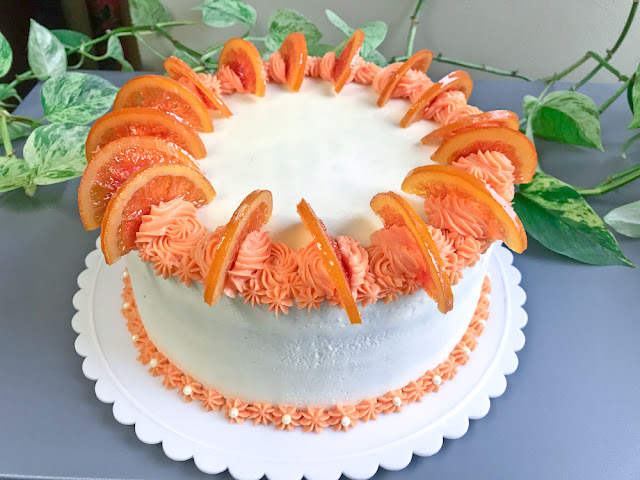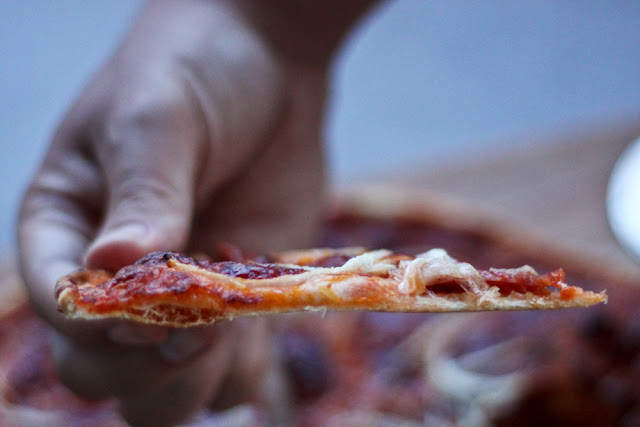Orange dream cake
Why?
Well, partly it's a great excuse to get everyone together and hang out while having a delicious treat. It's also a great excuse for me to make some pretty non-fondant cakes.
Yes, I do enjoy spending 15+ hours on a cake... once in a blue moon. (Check out flickr for all my creations!) But I tend to bake more traditional cakes (eg, yellow or chocolate) for my highly decorated ones and don't get to fully experiment with different recipes, flavors, or non-fondant decorations.
So baking monthly birthdays ends up being the perfect win-win situation for me!
January 2019 I decided on a citrus theme because citrus is both abundant and incredibly delicious during the winter season. But don't worry, you can easily make this cake year round.
So while I had made some candied ginger to accent the ginger flavor, I didn't use it in the end because it seemed more like an accessory than a cohesive part of the cake's flavor. The candied orange slices were perfect though!
But if you can figure out a way to get ginger flavor into the cake (powdered ginger?) and you'd like to include some candied ginger to go along with the cake, I used the Alton Brown recipe.
Feel free to mix/match any of the recipes below with your favorites! You don't have to make every single component from scratch either, but maybe the recipes will give you some ideas for your next creation.
Yours in providing her coworkers a healthy dose of vitamin C... along with their sugar,
Jacqueline
Orange dream cake
I'll start with the assembly directions, then provide each individual recipe below. The idea for using marmalade between layers (and ginger in the cake) was taken from Hungry Girl Por Vida.
Cake Assembly
When assembling cakes with multiple components I like to split it up across multiple days.
Day 1: Bake the cakes and let them cool. Wrap and store at room temp overnight.
Day 2: Make the filling/frosting and assemble the cake. If decorations are simple (as those below) you can do those on Day 2. If the decorations are a lot more involved (like my fondant-covered cakes) I like to do those on Day 3.
"Ingredients"
- Two 9" cake layers, each split in half for 4 total layers (recipe below)
- Orange cream filling (recipe below)
- Jar of orange marmalade, store bought or homemade (you'll need ~1/4 to 1/3 of a cup)
- Ermine frosting (recipe below)
- Candied orange slices for decorating, optional (recipe below)
- Place the first cake layer on a cake stand or plate. Spread 1/3 of the orange cream filling over the entire top of the cake.
- Spoon 1-2 TBSP of orange marmalade in the center of the cake and, using an offset spatula, spread the jam over the filling, making sure to leave ~1" border along the edges.
- Stack the 2nd layer of cake on top of the first and repeat steps 1-2.
- Stack the 3rd layer of cake and repeat steps 1-2.
- Stack the 4th layer of cake.
- Frost the entire cake with the Ermine frosting. I like to do this in 2 steps. First, crumb coat the cake by covering it with a very thin layer of frosting to seal in all the crumbs. After refrigerating the cake (making sure the crumb coat is hardened) frost your cake as normal. You can either keep the frosting simple or you can reserve some frosting for colorful piped decorations (as I did).
- Decorate with candied orange slices.
Yellow cake, adapted from Smitten Kitchen
I had originally added 2 TBSP grated fresh ginger to the cake but I couldn't really taste it at all after baking. So I did not note that addition below, but feel free to add if you'd like.
Ingredients
4 cups plus 2 tablespoons (480 to 530 grams due to variance between brands) cake flour
2 tsp baking powder
1 1/2 tsp baking soda
1 tsp table salt
2 sticks (1/2 pound) unsalted butter, softened
2 cups (400 grams) sugar
2 tsp (10 ml) pure vanilla extract
4 large eggs, at room temperature
2 cups buttermilk (475 ml), well-shaken
1 TBSP orange zest (~1-2 oranges)
Directions
- Preheat oven to 350°F.
- Butter two 9-inch round cake pans and line with parchment paper, then butter parchment. (Alternately, you can use baking spray with flour instead of the butter.)
- Sift together flour, baking powder, baking soda, and salt in a medium bowl.
- In the bowl of an electric mixer fitted with a paddle attachment (or large mixing bowl if you're using a hand mixer), beat butter and sugar at medium speed until pale and fluffy.
- Add vanilla and mix briefly to incorporate. Add eggs 1 at a time, beating well and scraping down the bowl after each addition.
- At low speed, beat in buttermilk and orange zest until just combined (mixture will look curdled). Add flour mixture in three batches, mixing until each addition is just incorporated.
- Spread batter evenly in cake pans, then rap pan on counter several times to eliminate air bubbles.
- Bake until golden and a wooden pick inserted in center of cake comes out clean, 35 to 40 minutes.
- Cool in pan on a rack 10 minutes, then run a butter knife around edge of pan. Invert onto rack, discard parchment, then flip the cake rightside up using a second rack. Cool completely, about 1 hour.
- If your cake has a large dome/hump on top, use a bread knife to level the top of the cake, making sure to snack on the cake bits.
- Split cakes in half before using. (A bread knife works best for this to avoid too many crumbs.)
Orange Cream Filling, adapted from The Cake Blog
I never use the full amount of powdered sugar called for in recipes as I find it wayyyy too sweet. Feel free to add as much as you need for the filling to have enough body without being too sweet for you. I usually start with about half as much and add more for taste/structure as needed. Below is the full amount from the original recipe as I didn't measure out my final amount.
Ingredients
3/4 cup unsalted butter, room temperature
4 1/2 cups powdered sugar (also called confectioner’s sugar)
9 TBSP mascarpone or softened cream cheese
zest of 3/4 large orange
fresh orange juice to thin out to desired consistency, as needed (about 1.5-3 TBSP)
Directions
- In the bowl of an electric mixer fitted with a paddle attachment, beat the butter until smooth.
- With the mixer on low, gradually add in the confectioner’s sugar until combined.
- Add in the mascarpone, orange zest, and orange juice and mix on medium-low until smooth. (Be sure not to over-mix the filling once the mascarpone has been added.)
Ermine Frosting, from Boston Girl Bakes
Ermine frosting is a cooked, flour-based frosting that has a texture that resembles whipped cream. Weird, I know, but it's delicious! And holds up better than whipped cream. In the past I've replaced the milk with coffee and it works great to give you a flavored frosting. You can also use a non-dairy based milk here if you'd like (eg, almond milk).
Ingredients
4 1/2 TBSP all-purpose flour
1 cup whole milk
1 tsp vanilla extract
Pinch of salt
2 sticks (1 cup) unsalted butter, softened
1 cup (198 grams) granulated sugar
Directions
- In a saucepan (or saucier) over medium heat, whisk flour, milk, and sugar and heat to a simmer. Stir frequently until it becomes very thick (almost like pudding).
- Remove from heat, whisk in vanilla and salt. Pour into a bowl and put plastic wrap on the surface to keep a skin from forming. Allow the flour mixture to cool completely. (You can refrigerate the mixture to speed up this process).
- Use an electric mixer with a paddle attachment to cream the butter until light and fluffy, scraping the sides of the bowl occasionally, about 5 minutes.
- With the mixer on medium, add the cooled flour mixture a little bit at a time. Continue to beat until the mixture becomes light and fluffy.
Candied Orange Slices, adapted from A Beautiful Plate
I didn't do it this time but I wonder if simmering the orange slices in water at least once (then dumping the water) would be useful here. That's the process I use for candying orange peels to get rid of a bit of their bitterness. You have to be a bit more careful with these full slices and avoid bringing them to a full boil, but that may work.
Ingredients
2 oranges, scrubbed
3/4 cup granulated sugar
2 cups water
2 TBSP light corn syrup
Directions
- Trim the ends of the oranges and slice into 1/4″ thick slices. (I used my mandoline for even slices.) Carefully remove and discard any seeds.
- Combine sugar, water, and light corn syrup in a very wide, deep skillet and bring to a boil, whisking continuously until the sugar has completely dissolved.
- Add the orange slices to the skillet in a single layer and bring to a low simmer. Simmer the slices in the sugar syrup for 1 hour, uncovered, or until the slices have become nearly transparent. Meanwhile, set aside a large baking sheet lined with a cooling rack.
- Once the slices are transparent, transfer them carefully with tongs from the poaching liquid, allowing any excess syrup to drip back into the pan, and place onto the cooling rack, laying them out flat to dry.
- Allow the candied orange slices to dry, uncovered, for a minimum of 24 hours, or until they are mostly dry, and minimally tacky.








Comments
Post a Comment